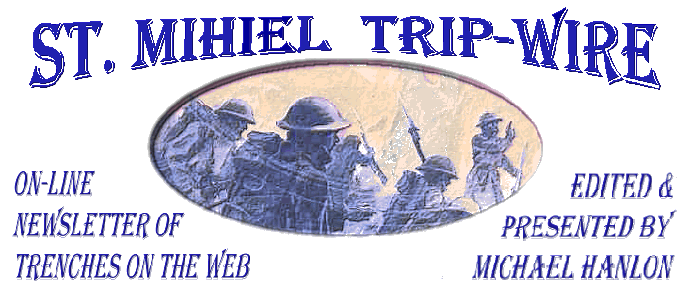
A problem at our hosting computer may make some links below inoperable and some archives inaccessible,
temporarily (we have been told). Our apologies.
TRENCH REPORT: Thanks to all of you who sent the very kind comments about our tribute to Professor Matthew Bruccoli, who passed away recently, shortly after I became acquainted with him. I did not realize we had so many F. Scott Fitzgerald fans among our readers. I was hoping to ask the professor just what Gatsby saw in Daisy, but I guess I'll have to wait to run into him in the next world to ask (my friends say Daisy is "the unobtainable," but I wanted to hear from "the authority"). . . Congratulations to Dana Lombardy, who has been elected new President of the Great War Society, succeeding Sal Compagno. We will have an interview with Dana soon and later with the new President of the Western Front Association's U.S. Branch when their upcoming elections are completed. . .I am off on another trip to the Western Front followed by a stop at the WFA-USA seminar at Carlisle, PA. In October, contributor Tony Langley, who is meeting us at Villeroy, France, site of a massive Battle of the Marne reenactment [and the home of Brie cheese], will be contributing a story and photos on the big event, and I'll report on the meeting. MH
This Month's Internet Feature
The Ill-Fated Kerensky
[or 2nd Brusilov] Offensive
The Kerensky Offensive, July 1917 by Michael Kihntopf
Brusilov Documents Related to the Offensive
Rumania's Part in the Attack
Kerensky Biography
Brusilov Biography
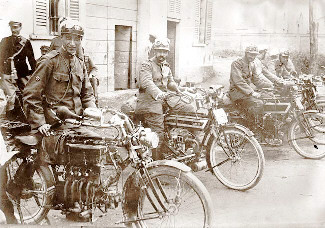
Italian Motorcycle Messengers
New at Our Own & Our Friends' Great War Websites
Click on Title or Icon to Access
|
Our Friends
At Great War Society Sites
At the WFA-USA
|

Question: Did the U.S. have food rationing in WWI?
Answer: During World War I, a voluntary policy of food conservation was devised by the United States Food Administration, headed by Herbert Hoover. Rationing of foods such as sugar, meat and flour were suggested, not mandated. "Meatless Mondays" and "Wheatless Wednesdays" were recommended. Americans were also encouraged to grow their own food and eat less to ensure a steady food supply.
Source: The Gale Group Virtual Library
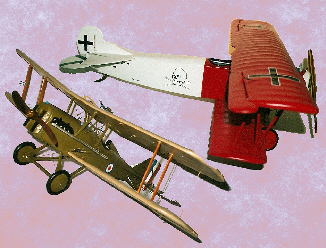 The German Fokker D.VII [upper] and the British SE5a
By Master Modeler Ray Morrisette
In September OVER THE TOP magazine, aviation technology expert Javier Arango explains why the two aircraft above were the dominant fighters of the war's last year.

Then in the lull of midnight, gentle arms
Lifted him slowly down the slopes of death,
Lest he should hear again the mad alarms.
Of battle, dying moans, and painful breath
From A Soldier's Grave by Francis Ledwidge
|

Von Richthofen as National Hero
Cover, German Magazine Jugend, No. 31, 1917
GREAT WAR 2008 EVENT CALENDAR
|
WFA-USA National Seminar
Carlisle Barracks, PA
America's Great War -
America's Great Warriors
September 12-14 2008 (information)
|
World War I Fly-In
Campbell Field Airport Weirwood, Virginia, USA
Aircraft of All Scales, Re-Enactors, Artists, Collectors, Historians, Modelers, and Vendors
September 13-14 2008 Email Rob Waring at: greatwaraerodrome@yahoo.com for information
|
WWI Military History Symposium
South Carolina Confederate Relic Room & Military Museum Columbia
Lectures, Living History, WWI Authors
November 15, 2008 Email Sarah Wooton Garrod at: swooton@crr.sc.gov for information
|
Western Front Association
U.S. Branch Chapter Meetings
Check for Your Region
Regularly Updated (details)
|
Great War Society Monthly Chapter Meetings
Berkeley, San Francisco and Palo Alto, CA
Regularly Updated (details)
|
Send additions/corrections:
Email Response
|

Memorable Event
|
The American Expeditionary Force Launches
Two Major Offensives
Two Weeks Apart
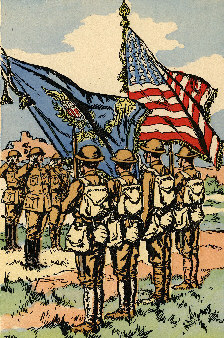
St. Mihiel & the Meuse-Argonne
September 12 & 26, 1918
Click on Image To Learn More
|
|
The Descendants and Friends 314th Infantry AEF wish to announce that on August 11- 13, 2008, after a written agreement was secured between the Descendants and Friends, Washington Memorial Chapel and the U.S. Army, the army removed the 314th Memorial Cabin collection on a loan basis for preservation at the Army Heritage and Education Center Carlisle, PA. The Descendants and Friends 314th are still working on securing the needed balance of funds for the actual cabin move itself, which the U.S. Army has expressed a great desire to accomplish. In the interim, the 314th Memorial Cabin is now closed to the public.
.
The Sgt. York Institute really needs your help. They have a major fund raising program underway now to preserve the school that the great Tennessee hero founded. Please visit their website: (link)
The next work in the Joseph Bruccoli series of World War I classics to be published by the University of South Carolina Press has been announced. It is:
This Man's Army: A War in Fifty-Odd Sonnets, by John Allan Wyeth, a verse treatment of the American experience in the war first published in 1928. The volume has been annotated by Trip-Wire reader and historian Bradley Omanson and includes an essay by British literary critic Dana Gioia. Order at: (link)
The Cantigny First Division Foundation & Museum with the partnership of the Sergeant York Project and Lost Battalion Association announces a series of 90th Anniversary Commemorations for the Meuse-Argonne Offensive scheduled for the weekend on October 3-5, 2008, including: the Battle of Fleville [and St. Juvin] ceremony Friday afternoon 3 Oct., additional events and displays at Landres St. Georges for the 2nd Division, at Chatel-Chéhéry for the 82nd Division and at Charlevaux Mill for the 77th Division. Also, on the nights of the 3-4 October there will be a "son et lumiere" with 150 reenactors at Montfaucon. Email Fred Castier of the First Division Foundation if you would like more information. (link)
|
Selection of War U.S. Posters From the
Committee for Public Information's Division of Pictorial Publicity
Don't Miss the Exhibit of American WWI Posters at the Bruce Museum in Greenwich, CT,
November 1, 2008 to February 1, 2009!
|
|
|
|
Page Two
|
|
|
Gladys Power, who fibbed about her age to enlist at 15 in the British Women's Army Auxiliary Corps, passed away in August at age 109 in Canada. She later transferred to the British Women's Royal Air Force. After the Great War, she emigrated to Canada with her first husband, Canadian soldier Ed Luxford. (link)
Click Here to See the Worldwide List of Surviving WWI Veterans
|

|
Sleeping Beauty #5
German 20th Pioneer Cemetery
By Christina Holstein
|

Front Gate of Abandoned Cemetery
Welcome to my latest Sleeping Beauty! This is the name I give to the forgotten vestiges of WWI that are buried in the far corners of the battlefields where almost nobody goes. The Argonne Forest is an area of France characterized by steep-sided valleys and impenetrable woods. A borderland between the Champagne region and Lorraine, the Argonne was for centuries regarded as an insuperable military obstacle and even today it is crossed by few roads. During World War 1 it was the scene of desperate fighting as the Germans, pushing down from the north, sought to cut the road and rail links between Paris and Verdun. With dense vegetation making clear observation impossible, the fighting here was characterized by mortars, grenades and, in particular, mining. American soldiers entered this inhospitable battlefield in September 1918 and found it extremely hard going, as their northward movement was always hampered by the east-west ridges so strongly fortified by the Germans.

Outside Wall
Four years of fighting have left many traces here, such as this former German cemetery, which stands at the side of the road from Varennes-en-Argonne to Four de Paris. It was built by the 20th Pioneer Regiment for their fallen comrades, but the men buried here were long ago transferred to other cemeteries in the area. The central monument, which features typical pioneer tools, now stands at the German Cemetery at Servon-Melzicourt, some miles away from its original site.
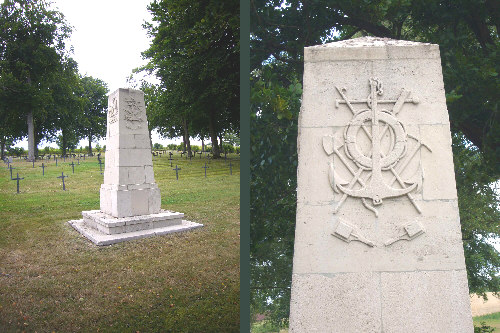
Main Monument and Detail
|
The Death of an Army Commander
From August 1914, by Alexander Solzhenitsyn
|
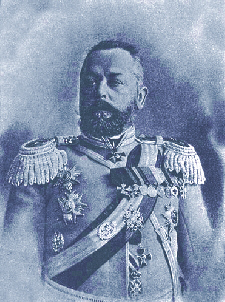
General Alexander Samsonov |
But they could never sit for long. The brief hours of night would soon slip away and with them, their last chance. Toward midnight, the moon lowered and was clouded over, together with the stars. They could see nothing in the dark as they stumbled along in single file sensing each other's presence only by the crackle of twigs underfoot and their own heavy breathing. The forest trail had got much worse. It was swampy and sometimes the way was barred by impenetrable undergrowth or by dense thickets of young pines. They thought it would be dangerous to stray in the direction of Willenburg where they could easily run into a German patrol. They bunched closer together and kept calling out in low voices. Now there were no more halts. Whenever they came to ditches, Kupchik and a Cossack captain gripped Samsonov by the arms and pulled him across.
What Samsonov found most burdensome was his body. Only his body. It dragged him down into pain, suffering, shame and disgrace. To rid himself of the disgrace, the pain and the burden, all he needed to do was to rid himself of his body. It would mean passing over to freedom—something he longed for—like taking a first really deep breath with his congested lungs. Earlier that night he had been reduced to a mere sacrificial idol for his staff officers. Now, after midnight, he had become more like a pillar of stone that could scarcely be moved any longer.
The hardest thing was to get away from Kupchik, who kept right behind him, sometimes touching his back or his arm. But as they skirted a thicket, Samsonov tricked his orderly. He slipped to one side and stood dead still. The sound of branches crackling and breaking, and the lumbering tread of heavy footsteps faded away.
It was quiet everywhere. The whole world was hushed. Armies had ceased to battle. Only a fresh night breeze stirred, ruffling the treetops. This forest was not hostile. It belonged neither to the Germans nor to the Russians but to God, and it gave refuge to all His creatures.
Leaning against a tree trunk, Samsonov stood for a moment and listened to the sound of the forest. Near by, the torn pine bark creaked in the wind. And above it all, just under the sky: the cleansing sigh of the treetops.
He felt more and more at peace. He had come to the end of his long soldier's career. He was abandoning himself to danger and death. Now ready to die, he had never imagined that it could be so simple, and such a release.
But the only trouble was that suicide is held to be a sin.
The hammer of his revolver clicked back softly. Samsonov placed it in his cap, which had fallen to the ground. He took off his saber and kissed it. He groped for the locket with his wife's portrait and kissed it too. He walked a few steps to a place where the sky showed through clearly. It was clouded over except for one tiny star that vanished, then appeared again. Dropping to his knees on the warm pine needles, he prayed with his face lifted to the star —he did not know which way was east. First he said the ordinary prayers, then none at all. He just knelt, looked at the sky and breathed. Now he groaned out loud, without restraint, like any other dying forest creature: "Lord, forgive me, if You can, and receive me. You see: There was nothing else I could do, there is nothing I can do."
Alexander Samsonov was the Russian commander who lost the bulk of his 2nd Army at Tannenberg and committed suicide at the end of the battle. Alexander Solzhenitsyn died on August 3, 2008. (Read an appreciation of his writings.)
|
|

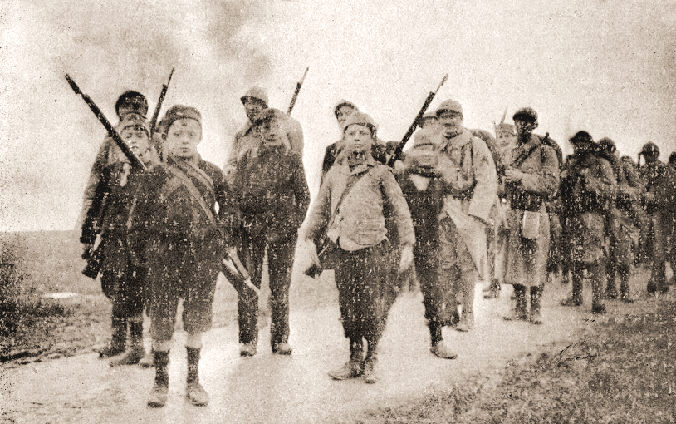
Enfants en Marche
From La France Illustree, No. 2201, 1917
Click Here to Visit War in a Different Light
|

|
1918 on The Western Front
By Tony Noyes
September
Roll Back
|
[Tony is a little indisposed this month, so we have drawn on other sources for this month's entry.]
The Allied successes in reducing the Marne Salient and of the advance before Amiens led to a reevaluation of the possibility of ending the war in 1918. Much strategic thinking to this point had been guided by the fact that the second wave of 2 million American troops would not be in place until April 1919.
Generalissimo Ferdinand Foch was an advocate for a broad advance to push the German army back across the Rhine. A critical part of his plan would be executed by a brand new American Army, under Pershing's command, which was just organized in August. After extensive negotiations, it was agreed that in a preliminary operation, this U.S. First Army would be given the job of reducing the St. Mihiel Salient which had threatened Verdun and the Allies' east-west rail communications for four years. Then, two weeks later they would shift their forces west for another offensive on the old Verdun battlefields. In this position they anchored the right end of a broad group of Allied offensives extending from the Channel, through the Somme sector and over through the Champagne to the immediate left flank of the Americans.
The coordinated assault would--in Foch's thinking--prevent Ludendorff from shifting reenforcements from hot spot to hot spot. Also, each of the individual operations had the potential for a dramatic breakthrough similar to what had happened in August at the opening of the Amiens attack. Such a breakthrough was not to be repeated in any of the sectors, but the strategy was sufficient to pressure Germany to seek terms in less than two months.
|
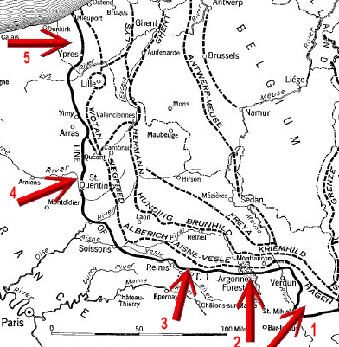
Allied Offensives Launched in September 1918
- 1. St. Mihiel
- U.S./Fr., Launched 12 Sept.
- 2. Meuse-Argonne
- U.S./Fr., Launched 26 Sept.
- 3. Champagne
- Fr. IV Army, Launched 26 Sept.
- 4. Somme
- Brit./U.S., Launched 29 Sept.
- 5. Flanders
- Belg./Fr./Brit/U.S. Launched 28 Sept.
|
If you are travelling to Europe and would like to visit these fields of memory for a detailed tour, please contact experienced guides Tony Noyes or Christina Holstein at Verdun Tours
|
|
Subscribe to Our New On-Line Magazine
|

|
|
|
Page Three
|
 |
The Battle of the Frontiers, Ardennes 1914
by Terence Zuber
Reviewed by Len Shurtleff, Editor of Len's Bookshelf
|
This is a first-class and long overdue study of the opening battles of World War I on the Western Front and the armies that fought them. It is also the first book in English on the Battle of the Frontiers fought in the Ardennes. Perhaps the most valuable part of this analysis is contained in the first two chapters in which Dr. Zuber examines the very different doctrine and training methods used by Germany and France. Not surprisingly, he finds German doctrine, tactical training and staff leadership vastly superior to the often slapdash French system. Specifically, the Battle of the Frontiers proved the superiority of German battle tactics and frontline leadership, as well as superior understanding of the importance of reconnaissance despite the frequent breakdowns of command and control at the divisional and corps level. The Germans emphasized patrols at all tactical levels and in all arms. While the French focused on maneuver, the Germans sought battlefield superiority through movement and firepower, including the use of their powerful, high angle-of-fire howitzer. Unlike the rigid French Army system of detailed written orders, Germany stressed flexibility and initiative among company and platoon commanders and even NCOs. These habits of command were reinforced by frequent peacetime field exercises at all levels of command. By comparison, French prewar training regimes were uneven and irregular.
Moreover, the Battle of the Frontiers did not prove the efficacy of either the German or French battle plans. Since prewar plans were not executed by either side, victory was the result of small unit successes based on superior German tactics and training. Also, the author contends, French defeat in the first battles of 1914 could not be laid at the feet of Grandmaison and his theories of offense á outrance, which were adopted too late to influence French 1914 tactics.
This book is thankfully full of those clear, useful maps often missing from military histories. The author made great use of German primary sources, including war diaries, as well as more limited and often fragmentary French sources. By 1914, as the author asserts, the German Army had reached its pinnacle, having learned to fight outnumbered and win even in the difficult terrain of the Ardennes. Therefore, it is fitting that this monograph concentrates on its operations.
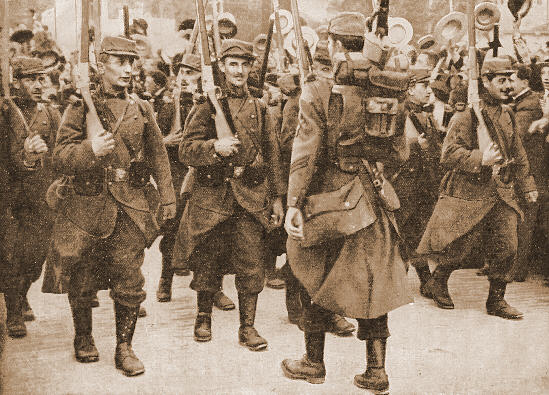
French Troops Leaving For the Front, August 1914
The Battle of the Frontiers, Ardennes 1914, Terence Zuber, Tempus, 2007, 314 pages, maps, photos, schematic sketches, orders of battle, end notes, glossary, ISBN 978 0 7524 4424 6, $34.96 cloth. Dr. Zuber is a retired U.S. Army Major and the author of Inventing the Schlieffen Plan: German War Planning 1871-1914 (Oxford 2002) and German War Planning 1891-1914: Sources and Interpretations (Boydell & Brewer, 2004).
|
Images from Valor Tours's
May 2008 Western Front Trip
Led by Trip-Wire Editor Mike Hanlon
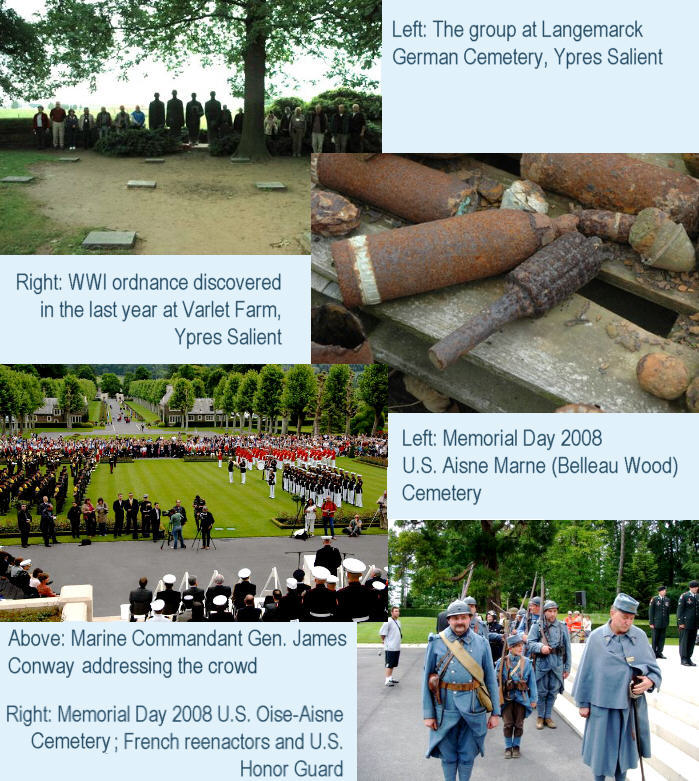
|
|
World War I Headlines
in the
21st Century
|
|
Ever in My Heart
By Andrew Melomet
This past August the Turner Classic Movies channel aired some rarely seen pre-code Barbara Stanwyck movies. Of special interest was Ever in My Heart (1933) directed by Archie Mayo and written by Bertram Millhauser and Beulah Marie Dix. In just 70 minutes, Ever in My Heart tells the story of Mary Archer's (Barbara Stanwyck) marriage to Hugo Wilbrandt (Otto Kruger) in pre-World War One New England and the subsequent events that destroy their happiness.

Poster for Swedish Version |
I had never seen or even heard of Ever in My Heart prior to this airing and I was completely surprised by its pace, its pre-code frankness and its explicit condemnation of a xenophobic America.
Mary Archer is expected to marry her cousin Jeff (Ralph Bellamy) when he returns from studying in Europe. Instead she falls in love with Hugo, a university friend who has accompanied him back to Archerville in New England. Hugo woos her by playing "Du, Du Liegst Mir im Herzen" on the family piano. Her family opposes her marriage to a foreigner, but the couple proceeds anyway. Hugo gets a position as a college chemistry professor and the young couple is very happy with Teddy, their young son (Ronnie Cosby) and the family dog, a dachshund.
Hugo becomes an American citizen, and during the ensuing celebration, a variety of songs are sung by the party guests indicating their national origins: "(I Wish I Was in) Dixie," "La Marseillaise," "Rule Britannia," "Yankee Doodle," "A Stein Song" and "Auld Lang Syne". There's no mistaking that Hugo is loved by his fellow faculty members and adored by his wife and young son. But the morning newspaper headline proclaims that Germany has invaded Belgium, and there's nothing but misery ahead for Mary and Hugo.
The sinking of the Lusitania places further strains on the family. Dismissed from his job, Hugo is snubbed by the community. Teddy dies (in a very moving scene while Hugo sings to him), some neighborhood children brutally stone the dachshund and Hugo is forced to shoot him. When they are nearly destitute during the winter, Mary's grandmother offers Hugo a job in the family mill if he will change his name. Hugo refuses but sends Mary off to her family, saying he will join her later. Just before Christmas Mary receives a letter from Hugo. He writes, "They let me be a citizen, but they won't let me be an American." Hugo abandons Mary and returns to Germany.
After America enters the war, Mary, Jeff and her younger brother Sam (Frank Albertson) all do their bit. Mary goes to Europe and while working in a canteen sees Hugo dressed as an American soldier. He's actually the spy that Jeff is looking for. Mary hides Hugo in her room and after making love for the last time she poisons their wine and they die together. The Rainbow Division is saved, and Mary and Hugo are gone.
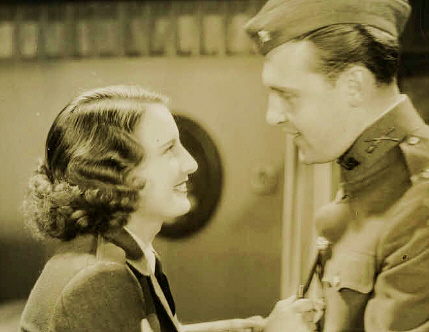
Barbara Stanwyck and Ralph Bellamy in the Film
Ever in My Heart received decidedly mixed reviews 75 years ago. For example, The New York Times felt that it "dipped into the limbo of forgotten war scenarios." And that "the tragedy is meaningless to this new generation." But it praised "the warm and intelligent acting of Barbara Stanwyck and Otto Kruger." This was Stanwyck's 16th film and her first truly tragic role. Kruger would play another German spy in Hitchcock's Saboteur (1942).
I feel that any movie prescient enough to portray a xenophobic American society prior to the 1942 internment of Japanese-Americans and the harassment of Muslim-Americans in today's post-9/11 society deserves to be re-examined. Unfortunately, Ever In My Heart is not available on DVD, so Turner Classic Movies channel is its only venue at the moment. It is not in frequent rotation, so if you're interested in seeing it you'll need to follow the TCM channel listings. It's worth the search.
[N.B. Some of the views expressed herein are solely those of our columnist. MH]
|
|
| The following are thanked for their contributions to this issue of the Trip-Wire: Christina Holstein, Tom Jones, Tony Langley Andrew Melomet, Ray Morrisette, Tony Noyes, Bradley Omanson, John Shetler, Len Shurtleff, and Kimball Worcester. Until next month, your editor, Mike Hanlon. |
SUBSCRIBE TO THE TRIP-WIRE
(Or send it to a friend)
(Or send us a comment on the TRIP-WIRE)
CLICK HERE TO CONTACT US VIA EMAIL |
For further information on the events of 1914-1918
and membership information visit the Directory Pages of:
|
| | |
























